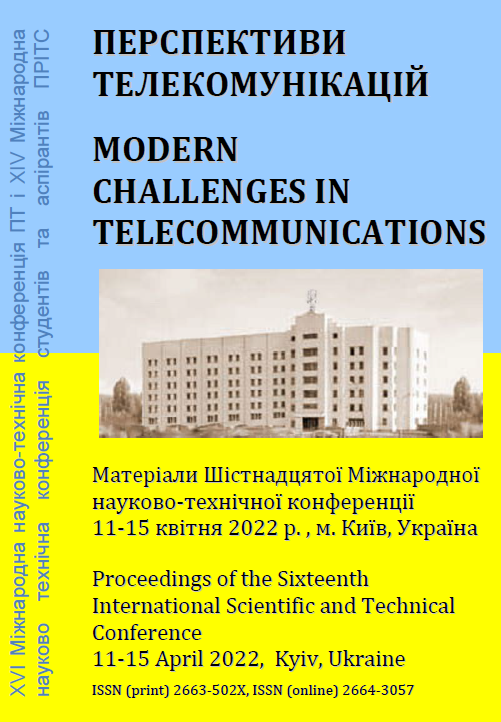МЕТОД ВИЗНАЧЕННЯ ЧАСТОТНО-ЧАСОВИХ МЕЖ ЗАЙНЯТИХ ДІЛЯНОК РАДІОЧАСТОТНОГО СПЕКТРУ
Ключові слова:
радіочастотний спектр; радіомоніторинг; тестова статистикаАнотація
На сьогоднішній день спостерігається постійне зростання кількості радіосистем, що використовують технологію когнітивного радіо. Основою таких систем є динамічне використання радіочастотного спектру [1-2]. Для визначення вільних ділянок радіочастотного спектру (РЧС) необхідно постійно аналізувати визначену смугу частот [3]. З іншого боку стрімкий розвиток бездротових технологій стимулює процес подальшого удосконалення систем радіомоніторингу. Тому розроблення методів визначення частотно-часових меж зайнятих ділянок РЧС в умовах апріорної невизначеності та динамічної зміни радіоелектронної обстановки є актуальним завданням сьогодення.Посилання
Elmasry F. G. Dynamic Spectrum Access Decisions. Local, Distributed, Centralized, and Hybrid Designs. JohnWiley & Sons Ltd., 2021. 728 p.
Liang Y.-C. Dynamic Spectrum Management. From Cognitive Radio to Blockchain and Artificial Intelligence. Springer, 2020. 180 р.
Captain K. M., Joshi M. V. Spectrum Sensing for Cognitive Radio. Fundamentals and Applications. CRC Press. 2022. 256 p.
Buhaiov M. V. Iterative method of radiosignals detection based on decision statistics. Visnik NTUU KPI. Ser. Radioteh. Radioaparatobuduv, 2020. № 81. рр. 11-20. DOI: https://doi.org/10.20535/RADAP.2020. 18.11-20.
Moon K. T., Stirling W. C. Methematical methods and algorithms for signal processing. New Jersey: Prentice Hall Inc., 2000. 937 p.
Kay S. M. Fundamentals of Statistical Signal Processing: Practical Algorithm Development. New York: Prentice Hall, 2013. 475 p.
##submission.downloads##
Опубліковано
Як цитувати
Номер
Розділ
Ліцензія

Ця робота ліцензується відповідно до Creative Commons Attribution 4.0 International License.
Authors who submit to this conference agree to the following terms:a) Authors retain copyright over their work, while allowing the conference to place this unpublished work under a Creative Commons Attribution License, which allows others to freely access, use, and share the work, with an acknowledgement of the work's authorship and its initial presentation at this conference.
b) Authors are able to waive the terms of the CC license and enter into separate, additional contractual arrangements for the non-exclusive distribution and subsequent publication of this work (e.g., publish a revised version in a journal, post it to an institutional repository or publish it in a book), with an acknowledgement of its initial presentation at this conference.
c) In addition, authors are encouraged to post and share their work online (e.g., in institutional repositories or on their website) at any point before and after the conference.

